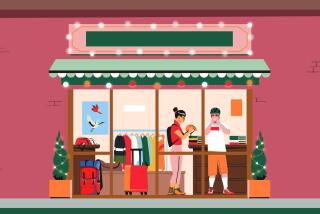‘You have to see the kids’ faces when they see a show’
- Share via
Ocean Beach resident Beverly Speach studies bubbles for a living. Speach, 25, the proprietor of Bubble Mania, delights children and adults alike by using basic principles of science to create diversely shaped bubbles. She moved to San Diego in 1985 after graduating from a State University of New York college with a bachelor’s of science degree in biology and education. Realizing the popularity of the bubble segment of demonstrations she gave at the Reuben H. Fleet Science Center in Balboa Park, she opened her own business as a bubble-ologist in 1986. Speach also teaches a variety of after-school science classes, but the bubble shows are by far the most popular. Speach was interviewed by Times staff writer Terry Rather and photographed by Barbara Martin Pinhero.
When I first moved out here after college, I immediately began working at the Space Theatre and Science Center in Balboa Park.
I was 21 and just got out of college. Part of my duties there was to do small demonstrations in science for the kids, and bubbles was one of the demonstrations. Pretty soon, I noticed hundreds of people watching my show.
I was disillusioned with my pay after going through four years of college, so I decided to start this business.
I was really broke at the time, trying to pay for an apartment and everything.
So I spent $10 on 1,000 business cards and started doing these bubble shows at libraries and passed out the cards, left and right.
Slowly I started doing enough business where I could afford to advertise. It just kept building and building. At this point, I am now moving into Orange County and Los Angeles with the business and I’ve just trained two people in Orange County.
I feel like I’m on the verge of an explosion.
The show is all based on science, and the kids become the scientists. They’re studying the bubbles.
We take them through really logical observations first. And, by knowing the simple properties of how they will react in a situation and with a little soap and water, I can do square bubbles and triangular bubbles, snowman bubbles, tiny bubbles.
I can make giant bubbles, put the kids inside of bubbles. The kids participate and together we discover why bubbles come out round, where all the colors come from and that bubbles don’t pop on everything they hit.
You have to see the kids’ faces when they see a show. I really like the kids.
They just give you their energy and love. I think young children have a wide-open mind to explore so many things, especially science; they are so curious about science.
Most people have looked at bubbles all their lives, played with them, and there’s so many things they never noticed because the first thing they do is pop them.
You don’t think about these things. You don’t think about why a rainbow happens. You’re just amazed by it, and you like it.
Bubbles are what I study. It doesn’t mean I sit home all day, or I’m a scientist with a lab coat on studying bubbles. But I have studied bubbles. . . . Most importantly, now I can share what I know about bubbles with students so they can become the bubble-ologist studying bubbles.
In addition to being a bubble-ologist, I teach a variety of classes around the county.
I teach hands-on experience in biology with dissections; chemistry, where they make their own slime; and physics, using laser light versus white light.
I work with a lot of preschoolers to sixth-graders to open their minds to science because that’s when they are most naturally curious about science.
They may not understand a lot of the things I do because some of the things are very high physics. My point is they not have to understand it, but they are exposed to the phenomenon, they’re excited by it, and, as they grow and hear it again in the classrooms, they’ll say, “Oh yeah! I remember that, I saw that when I was little. I remember how it worked, but I didn’t understand it then.”
That’s how my philosophy works.
If I were to go on to be an elementary school teacher now, it would be hands-on, something they can grasp.
I wouldn’t lecture, here’s what science is, here’s what biology is. I think that’s why my shows and classes are so popular. The kids do everything hands-on.
What they don’t realize is they are learning something. That’s what the show is all about.
More to Read
Sign up for Essential California
The most important California stories and recommendations in your inbox every morning.
You may occasionally receive promotional content from the Los Angeles Times.










